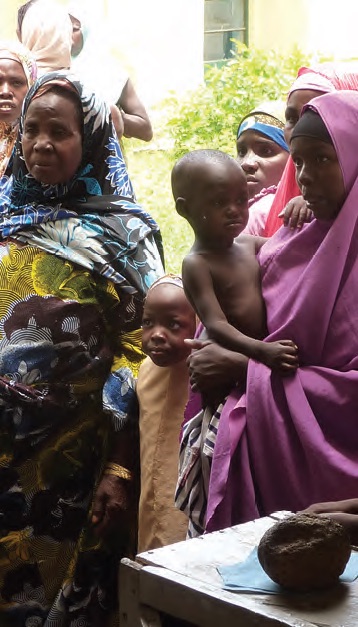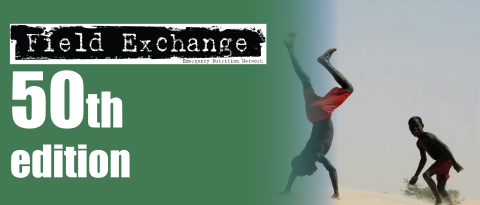MUAC outperforms weight-based measures of nutritional status in children with diarrhoea
Summary of research1
Location: Bangladesh
What we know: Undernutrition and diarrhoea often present concurrently in children. Weight is affected by hydration status; there is limited evidence on how this impacts on assessment of acute malnutrition in practice.
What this article adds: Between February and June 2014, a prospective cohort study assessed the validity of four different measures of undernutrition in children <5 years of age presenting with diarrhoea at the rehydration unit at ICDDR’B. Comparing measures pre- and post-hydration saw greater misclassification of nutritional status using weight-based measures compared to MUAC. Each 1% increase in dehydration was associated with a significant change in weight for age and weight for length z scores but no significant change in MUAC measures. The mean % weight change with rehydration was 4%. This study confirms previous research; it may partially explain why MUAC and weight for length z score often identify different populations of children.
Undernutrition and diarrhoea frequently present concurrently in children. In a recent study from Malawi, half of children presenting with severe acute malnutrition (SAM) in the outpatient setting reported having diarrhoea in the previous two weeks. Prior research has found that children with diarrhoea have decreased weight gain, children with undernutrition have a higher incidence of diarrhoea and the relation between malnutrition and diarrhoea is bidirectional. However, few studies have addressed the impact of hydration status on the assessment of malnutrition in children. Because dehydration alone will lower the weight of a child, weight-based nutritional assessments such as weight-for-length or weight-for-age in children presenting with diarrhoea may be misleading. A recently published study aimed to assess the validity of four different measures of undernutrition in children <5 years of age with diarrhoea by comparing performance of these measures during acute diarrhoeal illness and after rehydration to a stable, pre-illness weight.
The study used data collected as part of the ‘Dehydration: Assessing Kids Accurately’ study. This was a prospective cohort study that included a random sample of children presenting to the rehydration unit (short-stay unit) at the Dhaka Hospital of the International Centre for Diarrhoeal Disease, Bangladesh (ICDDR’B). The study was conducted between February and June 2014. The hospital provides treatment for ~144,000 patients yearly, over one-half of whom are children.
Method
All children <60 months of age presenting to the rehydration unit were eligible for enrolment. Acute diarrhoea was defined as the passage of loose or watery stools at least three times/d and lasting <14 d total. Research staff identified children presenting to the rehydration unit (24 h/d, 7 d/week) and randomly selected children for screening. Research staff screened the selected patient to determine if they met any of the predefined exclusion criteria (children with <3 loose stools/d, diarrhoea lasting >14 d, a clear alternative diagnosis to gastroenteritis on arrival, and children previously enrolled in the study).
Research nurses received seven days of training in all study procedures.2 After consent was obtained, study nurses obtained basic historic and demographic data for each child including location, age, gender, days of diarrhoea, stool frequency in the past 24 h, and type of diarrhoea (bloody, watery, or rice water). Children were completely undressed and baseline weight to the nearest 100g was obtained on arrival.
If a child received intravenous fluid before baseline weight was obtained, study staff recorded the amount of fluid received before measurements but did not alter the initial weight measurement. Mid upper arm circumference (MUAC) was measured in millimetres using a standard measuring tape. Hospital physicians determined rehydration methods independent of enrolment in the study; a majority received oral rehydration solution (ORS) alone and a minority received additional intravenous fluid. Nutritional measurements of dehydration status were performed in 721 patients <60 months of age before and after achieving stable weight through an independent hydration method. After initial enrolment, patients were weighed every eight hours to determine their post-hydration stable weight, which was used as a proxy for the pre-illness weight to determine the percent dehydration on arrival. The stable weight was defined as the average of the highest two consecutive weights that differed by <2%. A repeat MUAC assessment was performed on children achieving a stable weight before discharge.
Malnutrition was classified as none, moderate, or severe based on MUAC cut-offs >125, 115–124, or <115 mm, respectively, and by weight for length z score (WLZ) and weight for age z score (WAZ) by cut-offs of > -2, -2 to -3, or < -3, respectively. Of note, MUAC was measured for children 6– 60 months of age and MUAC z score (MUACZ) was calculated for children 3–60 months of age, based on available growth standard data.
Patients were classified into three dehydration categories based on their percent dehydration: no dehydration (<3%), some dehydration (3–9%) and severe dehydration (>9%); literature standards were used. Children who lost >3% of their body weight during their time in the rehydration unit were considered to have received inadequate rehydration despite persistent diarrhoea and were excluded from analysis.
 Results
Results
Between February and June 2014, 1,196 children <5 y of age were randomly selected for screening. Of these, 171 met exclusion criteria, 175 did not consent to participate, and 850 were enrolled. By discharge, 735 (86%) of all enrolled patients achieved a stable weight, allowing for calculation of their percent dehydration on arrival. Fourteen (2%) of these children lost weight during their stay in the rehydration unit, suggesting inadequate hydration in the setting of continued volume losses from diarrhoea and were therefore excluded from the analysis.
The mean percent weight change with rehydration was 4%. Eighty (11%) children were classified as having severe dehydration, 319 (44%) as having some dehydration, and 322 (45%) as having no dehydration. Median length of stay in the rehydration unit was 22 h (IQR: 16–38) and the median time to achieving stable weight was 14 h (IQR: 11–19).
Twenty-eight percent of children received intravenous fluids before their initial admission weight. However, for these children, the median amount of fluid received before their initial weight check was 1.5 ml/kg (IQR: 1.0–2.6), which is unlikely to be clinically significant in this context.
Comparing the pre-hydration and post-hydration malnutrition category assigned by each of the four indices of malnutrition in children, MUAC and MUACZ had a 92% and 94% agreement, respectively, with k-scores of 0.78. WAZ and WLZ had 68% and 76% agreement, respectively, with k-scores of 0.49 and 0.62. Based on a linear regression model analysing the impact of percent dehydration on the changes in anthropometric indicators with rehydration while controlling for age and sex, each 1% increase in dehydration was associated with a change in WAZ of 0.0895 (95% CI: 0.0892, 0.0905), and a change in WLZ of 0.1304 (95% CI: 0.1297, 0.1312). There was no significant change in MUAC or MUACZ with each 1% change in dehydration status. The change in each indicator with rehydration was analysed based on baseline dehydration category (none, some, or severe). Dehydration category had no significant effect on the change in MUAC (P = 0.32) or MUACZ (P = 0.07) with rehydration. However, dehydration category had a significant effect on the change in WAZ (P < 0.001) and WLZ (P < 0.001) with rehydration.
Finally, the study evaluated the impact of each of the four measures on the diagnosis of SAM in children with complete data available. Overall, 88 (12%) children were misclassified as severe underweight on arrival using WAZ and 104 (14%) children were misclassified as SAM using WLZ. Comparatively, only 10 (1%) children were misclassified as SAM on arrival using MUAC and 16 (2%) children were misclassified as SAM using MUACZ.
Discussion
Current WHO guidelines endorse using MUAC in community-based settings and WLZ in health facilities to diagnose children with SAM. In this study, a large proportion of children with diarrhoea were misclassified with SAM when using WAZ and WLZ whereas MUAC and MUACZ were far less likely to misclassify. Furthermore, dehydration status was found to have a significant impact on the accuracy of WLZ and WAZ, but not so for MUAC or MUACZ. This difference may partially explain previous research, which has shown that MUAC and WLZ often identify different populations of children with malnutrition3 and that WLZ can vary based on the severity of dehydration in the child.4 This study also confirms the findings of the one previous Kenyan study of malnutrition specifically in children with diarrhoea, which found that WLZ was a poor indicator of undernutrition in children with diarrhoea and that MUAC and MUACZ were not significantly affected by dehydration status.
Rapidly identifying vulnerable populations suffering from both diarrhoea and undernutrition has important clinical implications. This high-risk population can receive targeted therapy for their severe malnutrition, while also receiving specialised ORS (Resomal) for their dehydration. If providers are concerned that measures of undernutrition may not be accurate in children with diarrhoea, they may delay treatment for undernutrition until after rehydration in some children who truly need it, with an attendant risk that they may never receive it. MUAC overcomes this issue and has many advantages (easy to implement, simple measure and cheap). In community-based settings, it may not be possible to reassess the nutritional status of a child with diarrhoea after rehydration, because they are only evaluated at a single point in time before being sent home with sachets of ORS. In these cases, MUAC or MUACZ can be used to confidently assess nutritional status, enabling prompt diagnosis and initiation of community-based nutritional supplementation, without requiring the child to return for repeat assessment.
Limitations to the study include the fact that children with bipedal oedema and those with WAZ <-4 were not included in this study, because they are managed in a separate malnutrition unit at ICDDR’B. Furthermore, the study was conducted at a single urban hospital in Bangladesh, so the results may not be generalisable to more rural populations or those in other settings.
Footnotes
1Modi. P et al, 2015. Mid upper Arm Circumference Outperforms Weight-Based Measures of Nutritional Status in Children with Diarrhoea. The Journal of Nutrition. First published ahead of print May 13, 2015 as doi: 10.3945/jn.114.209718.
2Training consisted of 3 days of theoretical knowledge and 4 days of clinical experience practicing informed consent, weighing children, and measuring MUAC and length.
3UNICEF, WHO. WHO child growth standards and the identification of severe acute malnutrition in infants and children. Geneva (Switzerland):
4Berkley J, Mwangi I, Griffths K, Ahmed I, Mithwani S, English M, Newton C, Maitland K. Assessment of severe malnutrition among hospitalized children in rural Kenya: comparison of weight for height and mid upper arm circumference. JAMA 2005;294:591–7.


